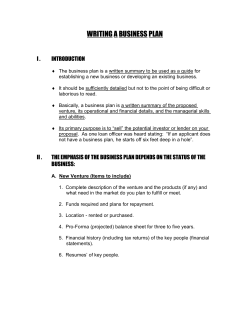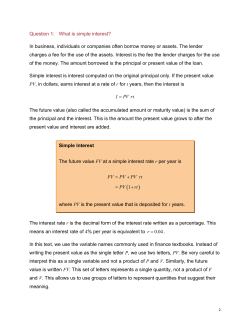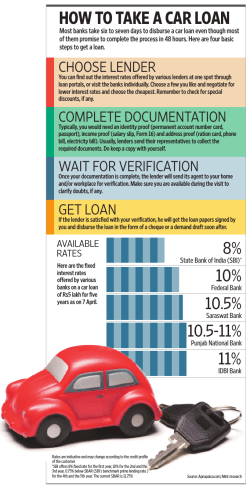
Microfinance its Opportunities and Limitations Suvendu Kumar Bishoyi
Microfinance its Opportunities and Limitations Suvendu Kumar Bishoyi JKPS/PGDM/09/50 Defining Microfinance • Micro-finance refers to small savings, credit and insurance services extended to socially and economically disadvantaged segments of society. In the Indian context terms like "small and marginal farmers", " rural artisans" and economically weaker sections" have been used to broadly define micro-finance customers. • Micro Finance is defined as "provision of credit and other financial services and products of very small amounts to the poor in rural, semi urban or urban areas, for enabling them to raise their income levels and improve living standards". • At present, a large part of micro finance activity is confined to credit only. Women constitute a vast majority of users of micro-credit and savings services. Scenario of Micro Finance in India India’s population is more than 1000 million, around 350 million, are living below the poverty. Only 20% access loan from the formal sources and 80% from the informal sources. Out of that 20% only 10% have access to Micro finance. Annual credit demand by the poor is estimated to be about Rs 60,000 crores. And only 12,000 crores are disbursed. (April 09) Customers of Micro Finance are “Small and marginal farmers", " rural artisans" and "economically weaker sections“ Demand for Credit: • In terms of demand for micro-credit, there are three segments. 1. At the very bottom in terms of income and assets, and most numerous, are those who are landless and are engaged in agricultural work on a seasonal basis, and manual labourers in forestry, mining, household industries, on struction and transport. This segment requires, first and foremost, onsumption credit during those months when they do not get labour work, and for ontingencies such as illness. They also need credit for acquiring small productive assets, such as livestock, using which they can generate additional income. 2. The small and marginal farmers and rural artisans, weavers and those self-employed in the urban informal sector as hawkers, vendors, and workers in household micro-enterprises. This segment mainly needs credit for working capital, a small part of which also serves consumption needs. In rural areas, one of the main uses of working capital is for crop production. This segment also needs term credit for acquiring additional productive assets, such as irrigation pumpsets, borewells and livestock in case of farmers, and equipment (looms, machinery) andworksheds in case of non-farm workers. This market segment also largely comprises the poor but not the poorest. 3. The third market segment is of small and medium farmers who have gone in for commercial crops such as surplus paddy and wheat, cotton, groundnut, and others engaged in dairying, poultry, fishery, etc. Among non-farm activities, this segment includes those in villages and slums, engaged in processing or manufacturing activity, running provision stores, repair workshops, tea shops, and various service enterprises. These persons are not always poor, though they live barely above the poverty line and also suffer from inadequate access to formal credit. Micro-Credits model Focus on, providing the capital for poor people to use their innate "survival skills" to pull themselves out of poverty. Lend mostly to poor people in small groups (credit circles), say of five or seven. Draw up a weekly or bi-weekly repayment schedule. In case any member defaults the entire circle is denied access to credit Mainstream Micro Finance Institutions • National Agricultural Bank for Rural Development (NABARD), Small Industries Development Bank of India (SIDBI), Housing Development Finance Corporation (HDFC), Commercial Banks, Regional Rural Banks (RRBs), the credit co-operative societies etc are some of the mainstream financial institutions involved in extending micro finance. Alternative Micro Finance Institutions • NGOs, which are mainly engaged in promoting self-help groups (SHGs) and their federations at a cluster level, and linking SHGs with banks, under the NABARD scheme. • NGOs directly lending to borrowers, who are either organised into SHGs or into Grameen Bank style groups and centres. These NGOs borrow bulk funds from SIDBI and various donors. • MFIs which are specifically organised as cooperatives, such as the SEWA Bank and various Mutually Aided Cooperative Thrift and Credit Societies (MACTS) in AP. • MFIs, which are organised as non-banking finance companies, such as Mirzapur and SHARE Microfin Ltd. Problems for Alternative Micro-Finance Institutions • Financial problems leading to setting up of inappropriate legal structures • Lack of commercial orientation • Lack of proper governance and accountability • Isolated and scattered Business model of GRAMEEN bank Introduction • • • • The Grameen Bank started in 1976 by the Nobel Laureate, Professor Muhammad Yunus in Bangladesh . Grameen today has some 2,468 branches in Bangladesh, with a staff of 24,703 people serving 7.34 million borrowers from 80,257 villages. Grameen‘s methods are applied in 58 countries — including the United States. Grameen Bank borrowers own 94% of the Bank. The remaining 6% are owned by the government. (January 09) Working model of Grameen bank: • • Manager first makes a round to the appointed area to introduce Grameen policies and programs. Try to make the group of 5 people. Conti…. • • • Only two members can obtain loan at first. After 6 weeks of successful repayment another two can apply for loan. The leader can only receive loan at last. Repayment responsibility solely rests on the individual borrower. However if one member of a group defaults, that group will never receive a loan from Grameen Two popular scheme by Grameen Bank is:• • Loan Insurance:Beggars Loan:- Conti…. The Repayment Mechanism: • • • • One year loan . Equal weekly installments . Repayment starts one week after the loan . Repayment amounts to 2% per week for fifty weeks . Criticism of Grameen Bank: • • There are rumors that there repayment rate are fake. Grameen Bank clients used their loans for many different purpose .e.g..Dowry, gambling etc. The Self Help Group (SGH) SHGs is a small group of rural poor, who have voluntarily come forward to form a group for improvement of the social and economic status of the members. Homogeneous group of about 15 to 20. Every member to save small amounts regularly. Every member learns prioritization and financial discipline. Condition required for membership for SHG’s • • • • • Members should be between the age group of 21-60 years. From one family, only one person can become a member of an SHG. (More families can join SHGs this way). The group normally consists of either only men or only women. Members should be homogenous i.e. should have the same social and financial background. Members should be rural poor. NABARD initiatives in Micro finance National Bank for Agriculture and Rural Development (NABARD) was established as an apex rural development bank in the year 1982, through an Act of Parliament. Role and Function of NABARD: • • • • • Providing Refinance to lending institutions in rural areas. Evaluating, monitoring and inspecting the client banks. Providing support to NGOs through a variety of schemes. Making model projects / development schemes for banks and farmers It prepares, on annual basis, rural credit plans for all districts in the country. Organizational structure Board of Director Chairman Managing Director Executive Director(4) Head Office Dept (24) Sub Office(Andaman & Nicobar) & Special cell (Srinagar) Regional Offices(28) Training Establishment(6) District Development Offices (391) Financial Santa Clause (NABARD) • • • (NABARD) was established in 1982,with an initial capital of 1400 crores. And till March 30, 09 it reached to Rs 1, 00,000 crores with the surplus of Rs 1400 crores. Its Reserve and Surplus increased by 10.26% from 07 to 08, and its Cash and Bank balance and Investment increased by 40.16% and 15.5%. (sources :nabard.org) Business model of SAKHI Introduction • • • SAKHI (An Organization for Women) , established in the year 2002. Started by veteran Mrs. Alpa Chauhan. SAKHI is having three office .(1 ) Dakoor (2 ) Umreth (3) Dahood. Role and function of SAKHI • • • • Provide loan to the economic disadvantage people. Help them in creating groups. Provide them Micro plus loans. Help them in establishing their(borrowers) business. Organization Structure SAKHI had developed a systematic organizational structure for itself. Board of Trustees CEO HR Mgr Operation Mgr Finance Mgr Area Mgr Audit Mgr Audit Team Brach Mgr FCO’s Brach Structure Brach Manager A/C MIS Officer FCO-JLG FCO FCO-GRLN Admin Mgr How SAKHI disburse the Loans? Loan Size: Cycle –I Rs 3000-Rs 5000 Cycle –II Upto Rs 8000 Cycle-III Upto Rs 12,000 Cycle- IV Upto Rs 15,000 Duration in months 12 Minimum Loan size Rs 3000 Maximum Loan size Rs 15,000 Repayment Frequency Monthly Rate of interest (P.a) 18% Upfront loan proceeding fees 2% Security Group guarantee followed by centre guarantee Sources: Survey on SAKHI How SAKHI raise capital? Friends of Women World Bank.(FWWB) (13.5% p.a ). Indian Bank(13.75% p.a). Why SAKHI charges such a high rate of interest (18% p.a)? • • • The loan doesn’t disburse immediately. SAKHI charges same rate, even if above hike there rates. High transaction and operating cost. Is government waiver plan effected there Institution? • • That rule was only for government institution. But borrowers also requested them to waive their loan amount. MFi’s being CritiCized beCause oF high interest rates: Most MFI’s financially sustainable by charging interest rates that are high enough to cover all their costs. Four key factors determine these rates: • • • • The cost of funds. The MFI's operating expenses. Loan losses. And profits needed to expand their capital base and fund expected future growth. There are three kinds of costs the MFI has to cover when it makes microloans: • • • The cost of the money that it lends. The cost of loan defaults. Transaction and Operating cost. Rate Ceilings: Not the Answer There is hue and cry on the high rate of interest which is being charged by many MFI’s. Policymaker concern over high interest rates. What are the reasons why rate ceiling can create disaster? • • • Rate ceiling will diminishing the return of MFI’s. If rates are set to a level less than that required to cover costs, it will lead to losses and also reduce their creditworthiness and ability to borrow. Compelled rate ceiling would increase more poverty in the economy. SWOT Analysis of micro finance Strength • • Helped in reducing the poverty. Huge networking available. Weakness • • • Not properly regulated. High number of people access to informal sources of finance. Concentrating on few people only and mainly in urban areas. Opportunity • • • • Huge demand and supply gap. Employment Opportunity. Huge Untapped Market. Opportunity for Pvt. Banks, NBFCs, Foreign Banks to enter this business segment. Threat • • • High Competition. Neophyte Industry. Over involvement of Govt. Future of Micro Finance Estimated that in next five years, 65% of the poor people will have excess to MFIs. Many Pvt. Banks and Foreign Banks would enter this business segment, because of very low NPAs. Estimated that 5 % of the number of people below the poverty line will get reduced in the next 5 years.(World Bank report) Thank you
© Copyright 2025











